
Hue, Vietnam cover page. |
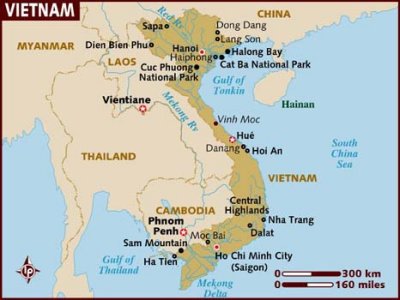
Map of Vietnam with the star indicating Hue. |

Tourist boats with dragon mastheads docked on the Perfume River in Hue. |
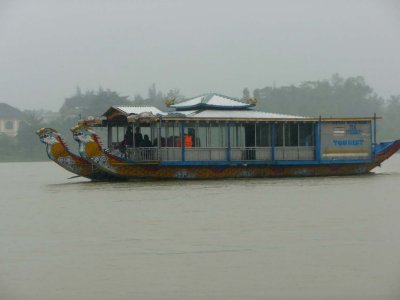
A tourist boat like mine passed by as I cruised on the Perfume River. It was raining in Hue that day. |
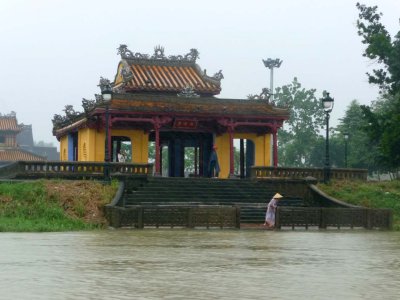
An interesting Vietnamese building on the bank of the Perfume River. |

This boat is carrying sand that is dug from the bottom of the Perfume River. The sand is used for construction. |

The boat let me off at the entrance of Thien Mu Pagoda. It is situated on Ha Khe Hill. |
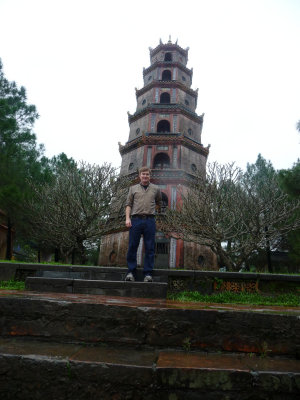
Me in front of the stupa. The pagoda's legend is: long ago, an old woman appeared on the hilltop. |
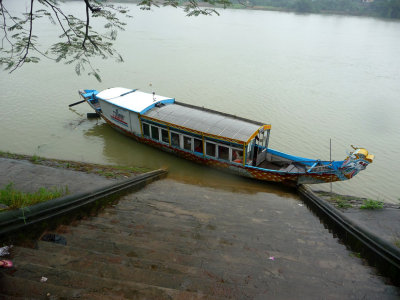
She said a Lord would come to build a pagoda for prosperity; thus, Lord Nguyen Hoang built the pagoda of the "Heavenly Lady". |
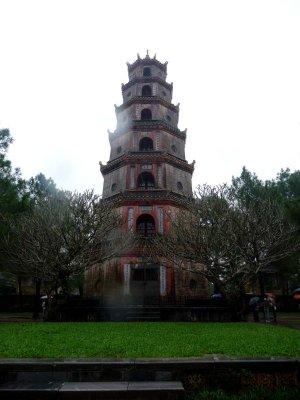
View of the stupa of Thien Mu Pagoda. It has seven storeys and is the tallest in Vietnam. |

Closer view of the stupa. The pagoda was built in 1601, and the stupa (the Phuoc Duyen Tower) was erected in in 1884. |

In 1715, Lord Nguyen Phuc Chu erected this marble tortoise with a stele on its back. A tortoise symbolizes long life. |
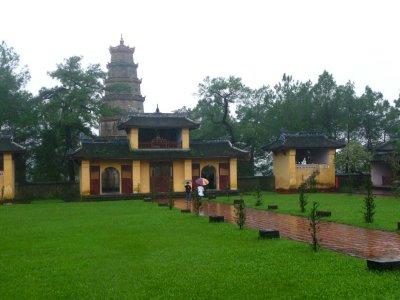
View toward the sanctuary. The monks quarters are there. |

The sanctuary has a long hall in the front, with a wall of shutter doors leading to the alter behind. |
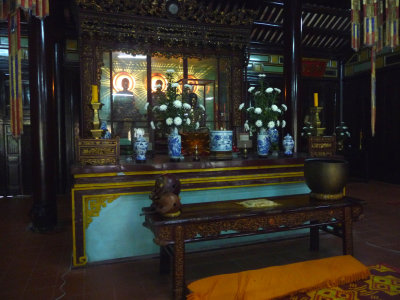
Buddhist alter inside of the sanctuary. |
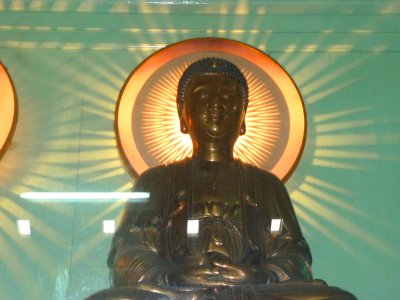
Close-up of the illuminated Buddhist image at the alter. |

Monks having lunch in the sanctuary where they live. |
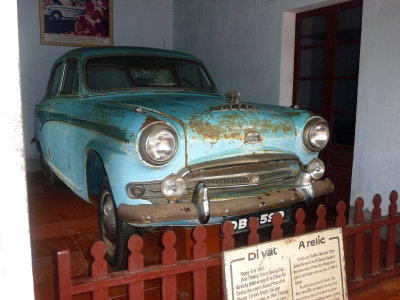
In 1963, a monk from Thien Mu Pagoda drove this Austin to Saigon and burned himself to death as resistance to the Diem regime. |
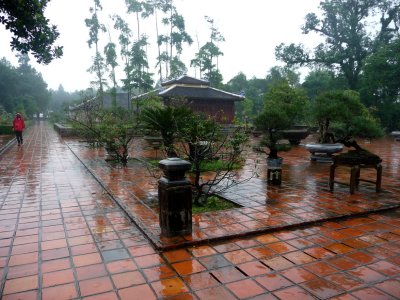
One of the courtyards behind the sanctuary. Along one side are the monk's quarters. |

One of several small pavilions in a courtyard behind the sanctuary. |
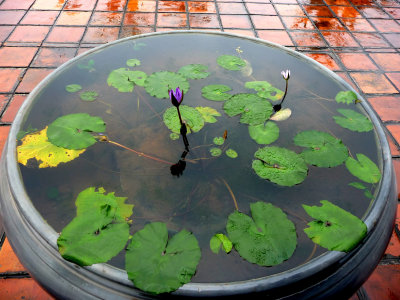
A small lily pond in one of the courtyards of the Thien Mu Pagoda. |
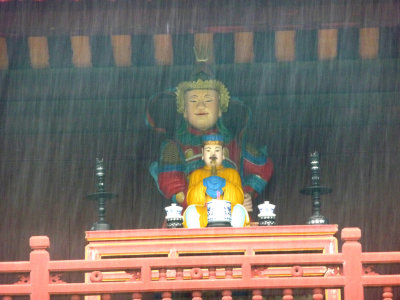
On the top floor of the sanctuary, is this Buddhist statue. You could see that it was raining hard that day. |
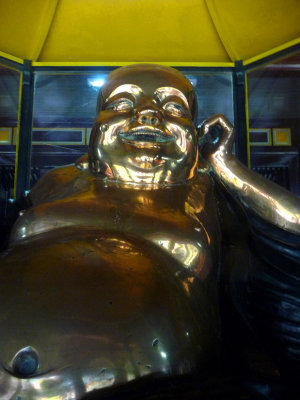
A happy Buddha (with a big belly) in the sanctuary at the Thien Mu Pagoda. |
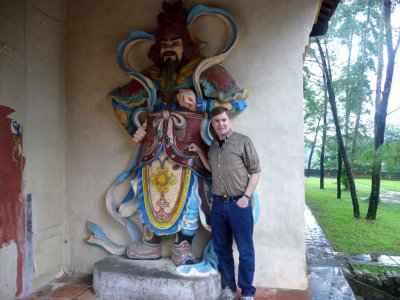
There are many wonderful wooden carved figures at Thien Mu Pagoda including this one that I am standing next to. |
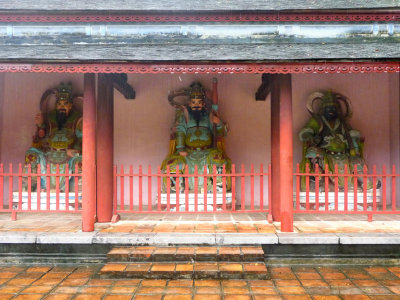
These wooden sculptures depict the wooden gilded board. Lord Nguyen Phuc Chu's inscriptions are written on them (1714). |
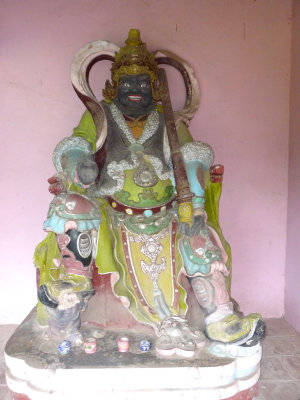
This is the wooden gilded board member on the right. The details are wonderful! |
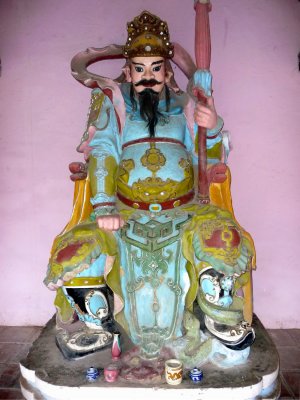
This is the wooden gilded board member in the middle. |

This is the wooden gilded board member on the left. The colors are terrific! |
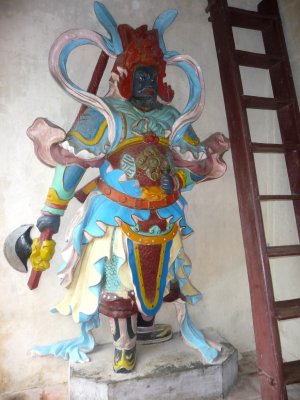
Another wonderful wooden carving at Thien Mu Pagoda. This one has a weapon so, he must be a temple guardian. |

This one must be a temple guardian, too, since he is carrying a sword. |

This is the main entrance leading to the main gate of the Citadel (Imperial City) in Hue. |
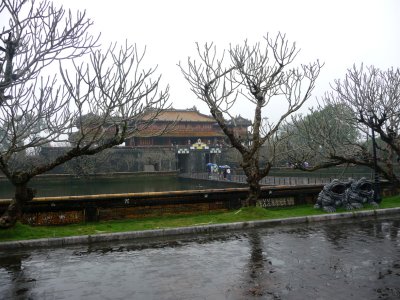
You have to cross over water when entering the main gate. |
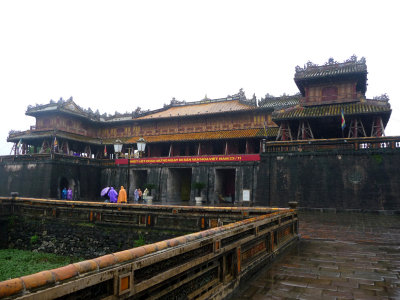
The Ngo Mon Gate (Moon Gate) is the main gate and the royal viewing area of the Imperial City of Hue. |
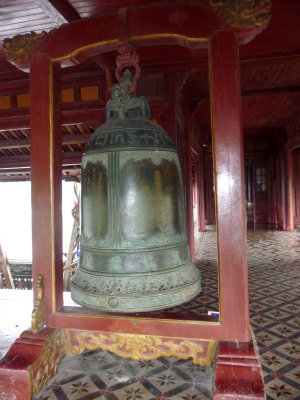
This large bronze bell was cast in 1710. in times past could clearly be heard in the Citadel and in the surrounding villages. |

Side view of the Ngo Mon Gate from the level of the royal viewing area. |
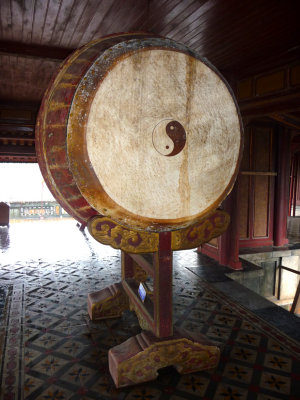
This drum (or gong) at the Ngo Mon Gate was used to summons people. |

Notice the rain gear worn by these tourists at the Ngo Mon Gate. I rained that day. |
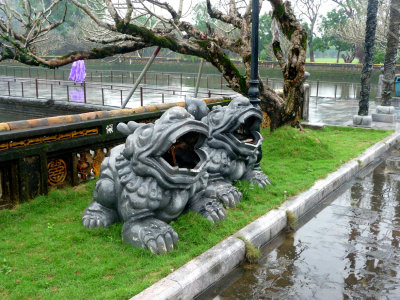
Dog-like sculptures at the Ngo Mon Gate of the Citadel (Imperial City). |

Inside the Citadel, I came across this wonderful unicorn sculpture. |
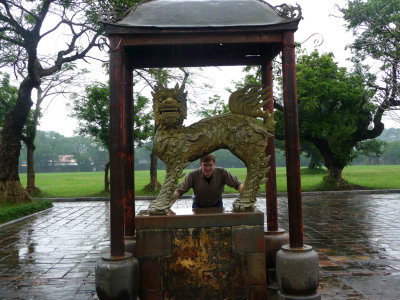
Me posing behind the unicorn. |

Courtyard at the Dien Thai Hoa (Palace of Supreme Harmony), the largest and most majestic palace at the Citadel complex. |

A dragon ceramic vase in front of Dien Thai Hoa. |
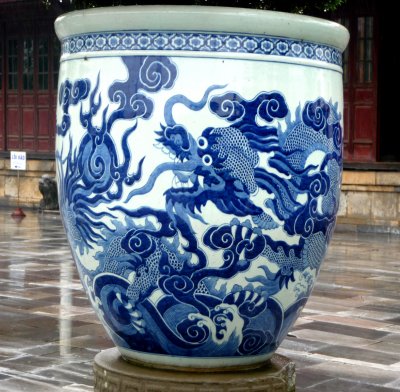
Close-up of the dragon ceramic vase. |
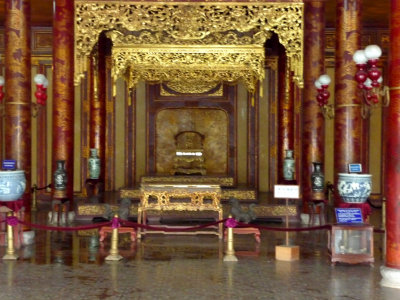
Dien Thai Hoa is important because it houses the golden throne, considered a holy relic and the seat of the monarchy. |

Interior of the Palace "Supreme Harmony." If the emperor ruled with the harmony of Yin an Yang, it would bring good luck to all. |
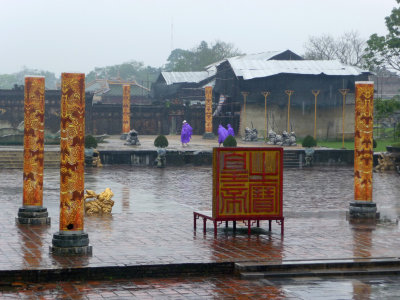
Exterior courtyard with decorative columns in the Citadel complex. |
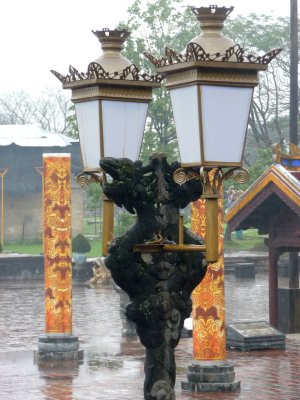
Interesting dragon stone carving between these two lamps. |
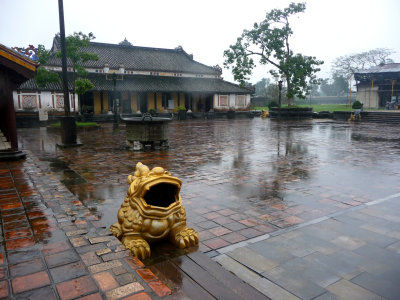
More Citadel buildings on a very rainy day. |
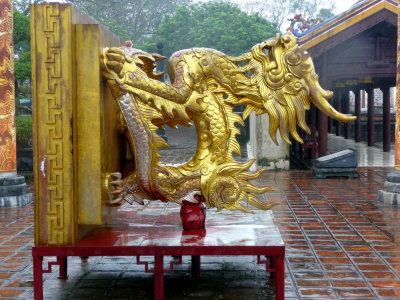
I was intrigued why this golden dragon sculpture was turned on its side. |
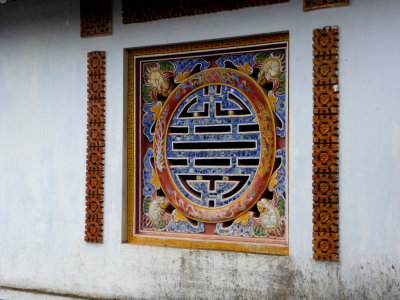
Ceramic window decorations such as this one are common at the Citadel. |
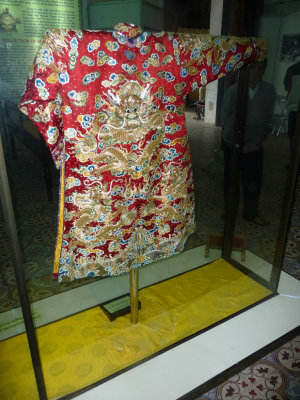
This is a reproduction that was on display of the Prince Military Gown in Nguyen Times (1802-1945). |
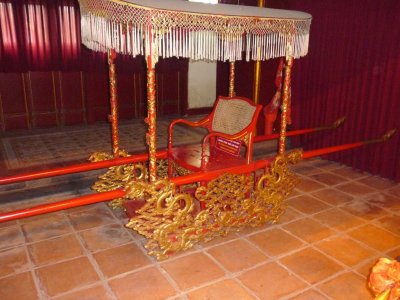
The monarch was transported around the Imperial City in this royal rickshaw. |

Interior of the stage of the Duyet Thi Royal Theater. Dating from 1826, traditional operas are performed here. |

Dragon sculpture in front of Duyet Thi Royal Theater. |
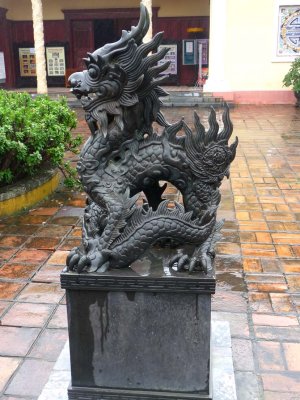
Close-up of the dragon sculpture. |
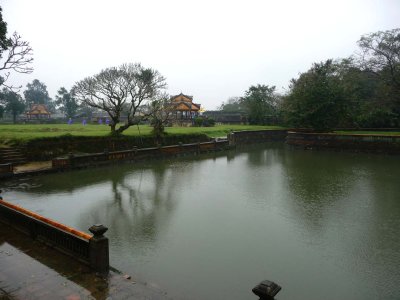
This pond is on the Citadel grounds near the Duyet Thi Royal Theater. |
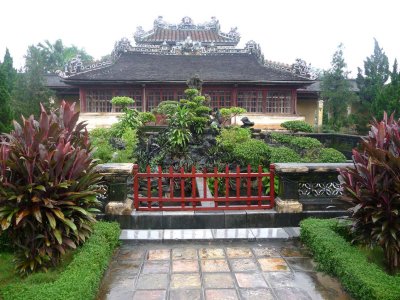
Landscaping in front of the pond with a Citadel building with a very elaborate roof in the background. |

A gazebo with wonderful dragons on the roof at the Citadel complex. |
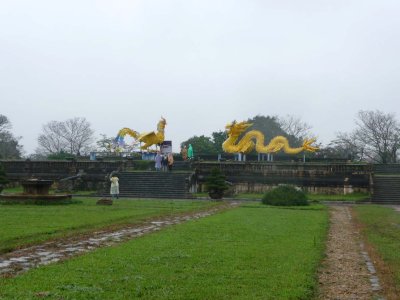
A temporary display at the Citadel entitled "When dragon meets Phoenix," a collaboration of Australian and Vietnamese artists. |
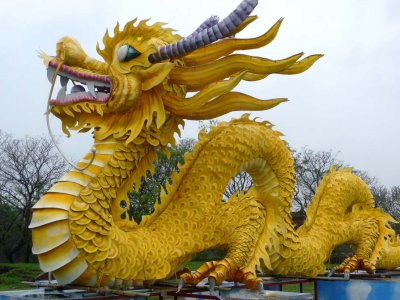
This is the dragon, which appears to be made out of paper or fabric. |

Close-up of the phoenix. |
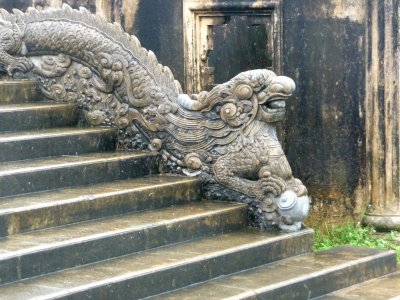
I came across this interesting dragon banister sculpture at the Citadel complex. |

Here's another dragon sculpture on the rooftop of a Citadel structure. |

A wet pathway that was leading towards some of the emperors' temples, including Hung Mieu and Thé Mieu. |
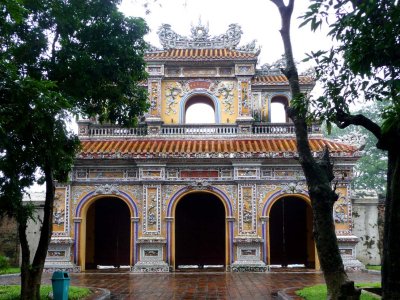
Note the elaborate details on this gate. This was one many that I admired since there are so many. |

One of several entrance gates to Hung Mieu, a temple that is devoted to the worship of King Gia Long's parents. |

Another gate at Hung Mieu with very elaborate designs on its façade. |
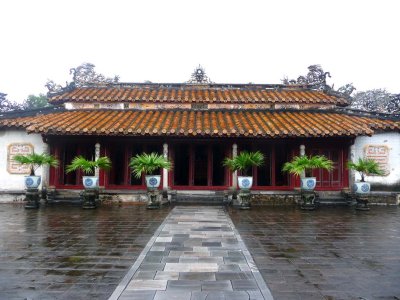
View of the Hung Mieu temple and the courtyard in front of it. |

Note the potted plant in front with the beautiful dragon design on the pot. |
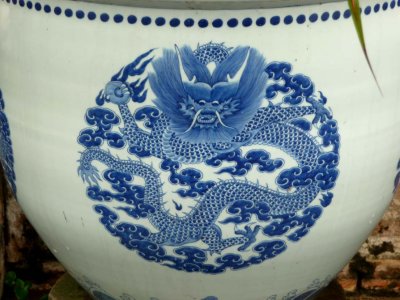
Close-up of the dragon design. |
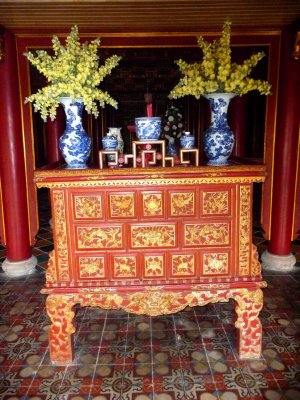
A work of 19th century Vietnamese furniture inside of Hung Mieu. |
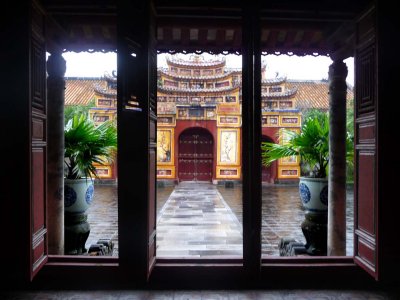
View looking from the inside of Hung Mieu of the gates across from the courtyard. |
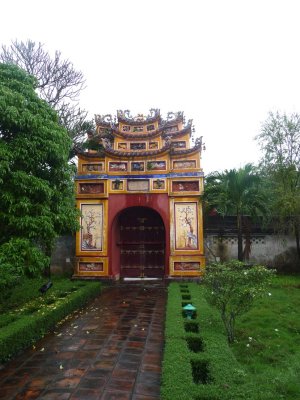
Gate from which I left Thieu Mieu. It has very intricate Vietnamese designs on top and on its façade. |

Pathway and gate leading to the second major temple in this compound called Thé Mieu. |
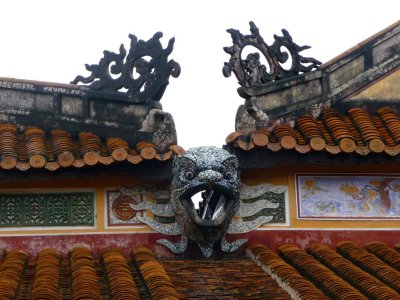
Note the wonderful designs on the top of this gate leading to Thé Mieu. |
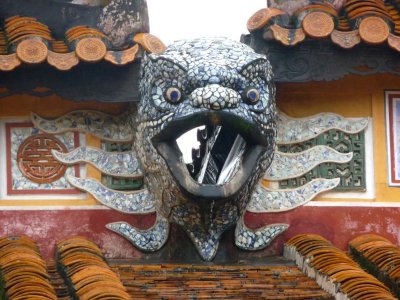
Close-up of a bird-like mosaic face on top of the gate. |
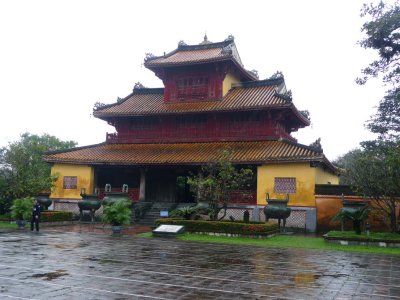
View of the Pavilion of Everlasting Clarity (Hien Lam Cac) situated at the center of Thé Mieu's courtyard. |
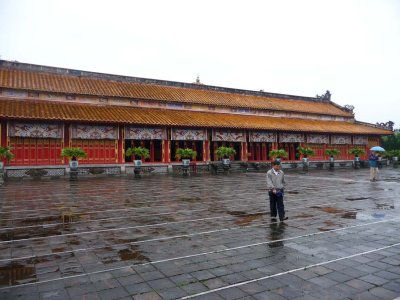
Thé Mieu is located across the courtyard from the Pavilion of Everlasting Clarity. |

The courtyard separating the Pavilion of Everlasting Clarity and Thé Mieu is quite big. |

This looks like an old-fashioned telephone booth, but there is a statue of a unicorn inside of it. |

The pavilion, which was built in 1821 by King Minh Mang, has steps with dragons on them. |
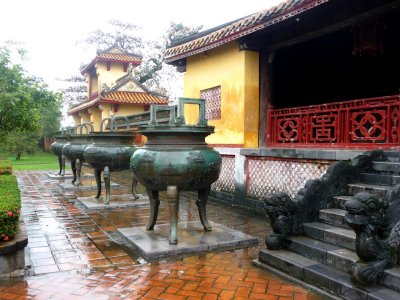
Standing in front of the pavilion are 9 dynastic bronze urns from the 19th century. |
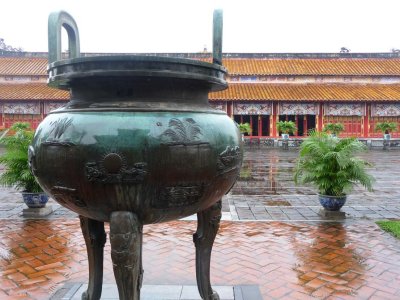
Close-up of one of the urns, which weighs approximately 2 tons. |
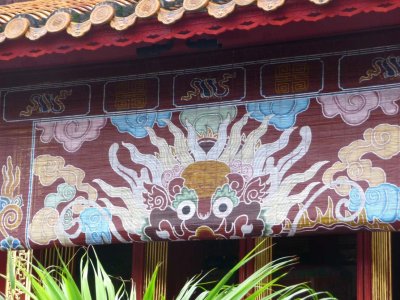
Beautiful dragon designs on these unusual window shades at Thé Mieu. |
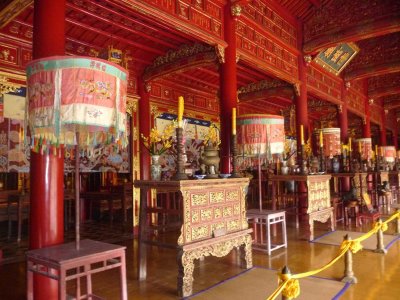
The interior of Thé Mieu is richly decorated in black and red with patterns in gold. |

View looking out from the inside of Thé Mieu to the Pavilion of Everlasting Clarity. |
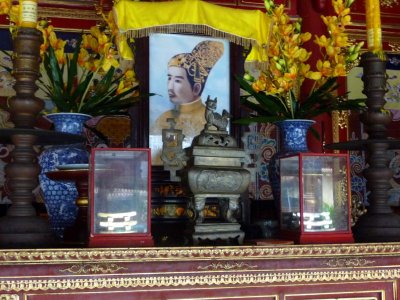
Inside, there is an altar to each Emperor with an image, painting or photo of them. |
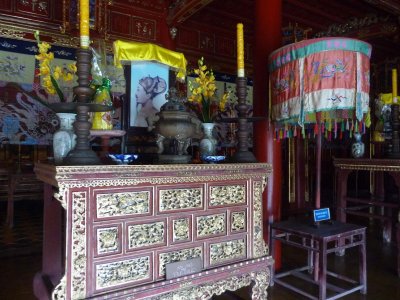
Another alter dedicated to one of Vietnam's emperors. |
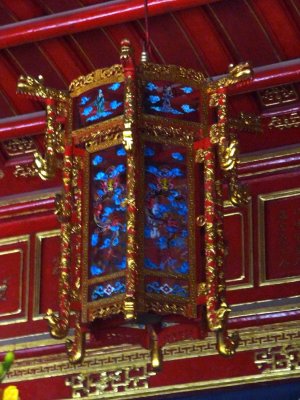
A very lavish and lush looking lantern adorns the ceiling of Thé Mieu. |

This is one of the entrances to Thé Mieu. It needs restoration work, but it is still magnificent. |

Close-up of a dragon design on the façade of the entrance. |

Entrance to Tu Duc's tomb (which he helped design). He became emperor in 1847 and ruled for 35 years until he died at age 55. |

Luu Khiem Lake at Tu Duc's tomb. It is located in a narrow valley in Duong Xuan Thuong Village. |
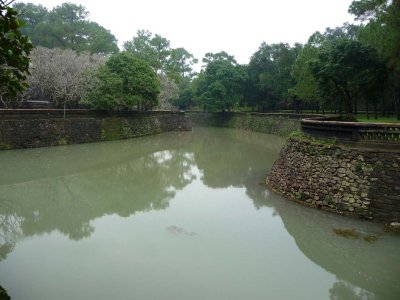
So great was the expense of the tomb's construction, that there was an unsuccessful coup attempt in 1866 to replace the emperor. |

The tomb is one of the most beautiful works of royal architecture of the Nguyen Dynasty, lying in a pine forest, 8 km. from Hue. |

Xung Khiem Pavilion, where the emperor would sit with his wives and concubines and read books, compose and recite poems. |
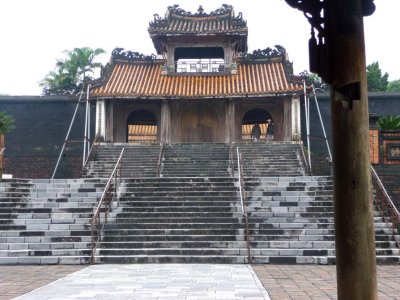
Entrance to the Hoa Khiem Palace, where the emperor used to work. After he died, it became a temple to him and his empress. |
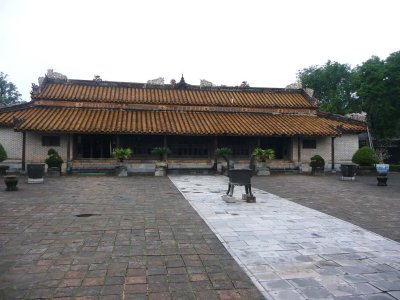
Courtyard with an incense burning urn and with Hoa Khiem Palace buildings that Tu Duc used when he was alive. |
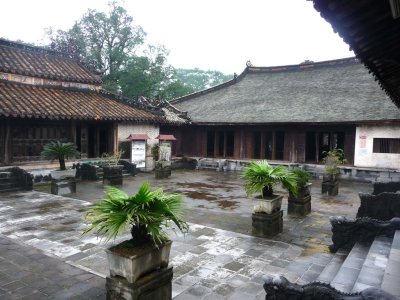
More courtyard and Hoa Khiem Palace views at Tu Duc's tomb. |
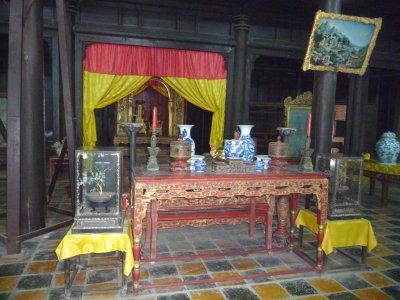
Some of Tu Duc's personal possessions on display inside the Hoa Khiem Palace. |
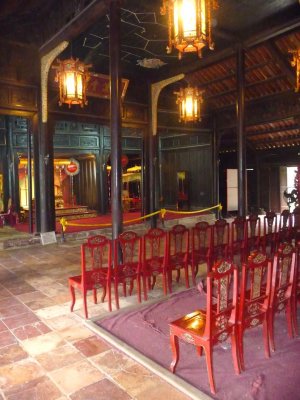
View of the exquisite interior of Hoa Khiem Palace. |
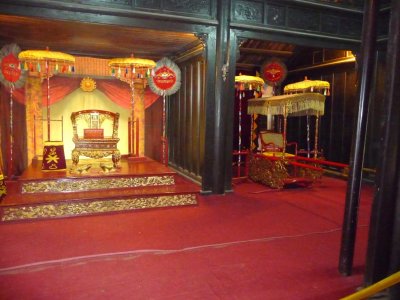
Tu Duc's throne and his royal rickshaw were on display there. |
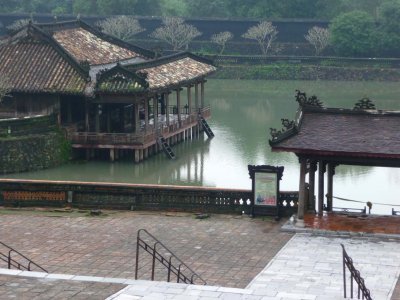
View from the top of the stairs of Xung Khiem Pavilion on Luu Khiem Lake. |

From the Hoa Khiem Palace, you make your way to the area of the emperor’s tomb. |
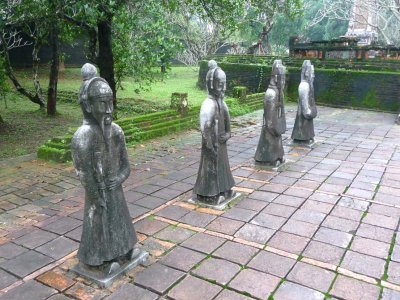
You pass an honor guard of elephants, horses, and diminutive government and military officials. |
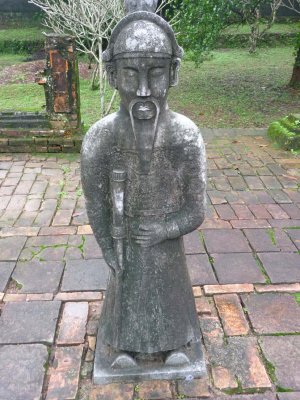
The officials were deliberately made to be smaller than the emperor (so as not to overshadow him)! |

Part of the honor guard of elephants and horses. |
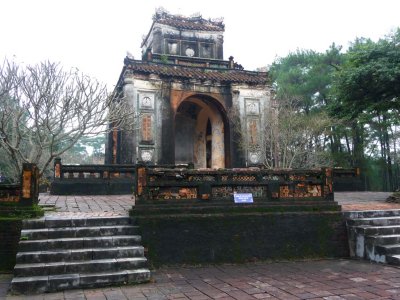
Here, you arrive at the Stele Pavilion, which houses the biggest stone tablet in Vietnam (weighing 20 tons). |
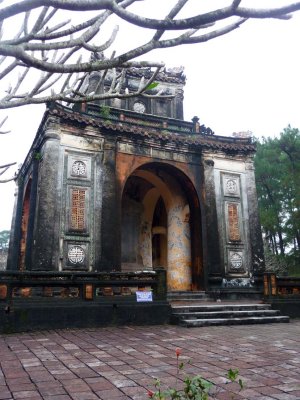
Closer view of the Stele Pavilion. You can see the massive stone tablet inside. |

Me taking a break in front of Stele Pavilion. |
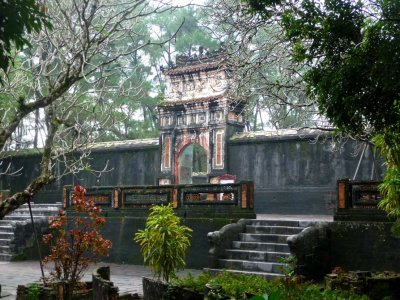
A side view of the Stele Pavilion through the trees. |

These trees on the other side of the Stele Pavilion are magnificent! |
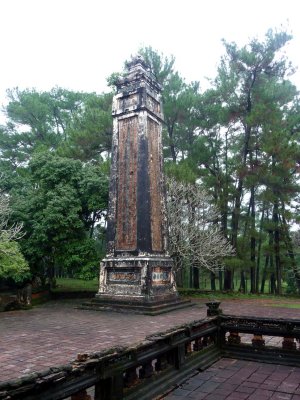
Two stone pillars stand behind the Stele Pavilion. Not being modest, inscriptions on them give hommage to Tu Duc's power! |

From the Stele Pavilion and pillars, you pass through this ornate ceremonial gate. |

You arrive at the Emperor’s sepulcher (it's a bit of an anticlimax)! The emperor isn't entombed there for fear of grave robbers. |
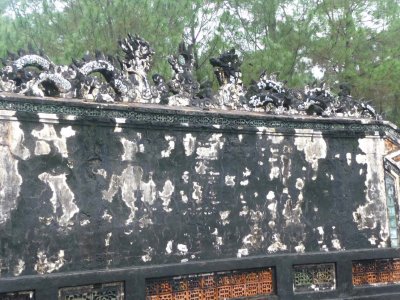
Detail of the wall behind the sepulcher. The tomb needs a lot of restoration work. |
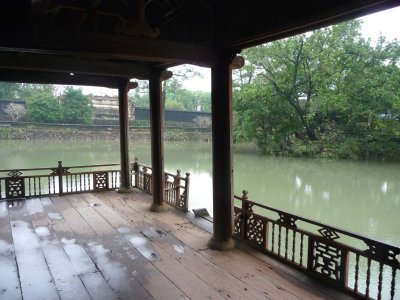
Next, I went to the Xung Khiem Pavilion which is one of the most beautiful spots of Tu Duc's tomb. |

View looking towards Hoa Khiem Palace from the Xung Khiem Pavilion. |

After leaving Tu Duc's tomb, I went to an incense shop where this Vietnamese girl taught me how to make incense sticks. |
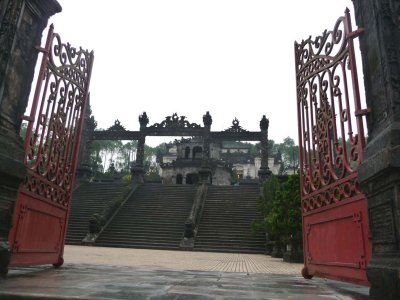
The next stop was at Khai Dinh's tomb. He was Vietnam's last emperor, ruled for 9 years (1885-1925) and died at age 40. |

Khai Dinh chose the slope of Chau Chu Mountain (10 km. from Hue) to build his tomb. Construction lasted for 11 years. |
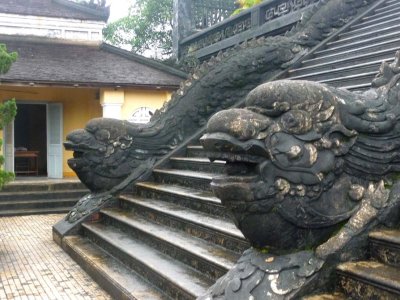
Compared to preceding emperors, King Khai Dinh's tomb is small. It is very elaborate as can be seen from this dragon stairway. |
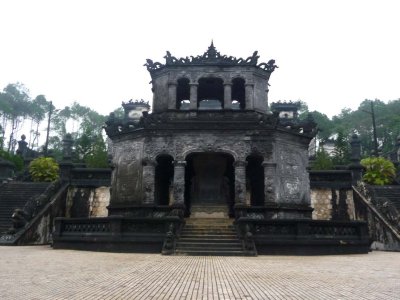
These are the entrance gates and the first level of Khai Dinh's Tomb. |
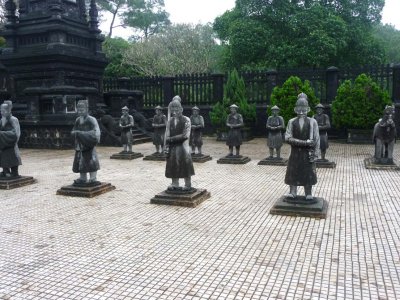
As with Tu Duc's tomb, there is an honor guard of diminutive government officials, horses and elephants. |

Close-up of one of the diminutive government officials at Khai Dinh's tomb. |
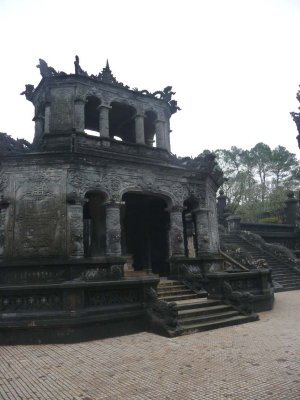
These entrance gates are very majestic. The tomb was built with modern materials, such as steel and reinforced concrete. |
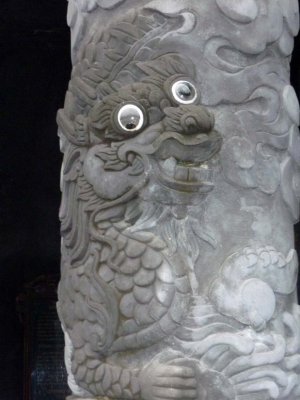
An unusual dragon carving on the entrance gates. There are magnificent dragon decorations everywhere in King Khai Dinh's tomb. |
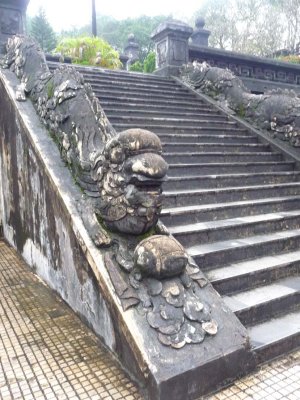
Another dragon stairway leads up to the third level of the tomb. |

Looking down from the third level of the tomb at the entrance gate. |

A frontal view of the entrance gate from the third level of the tomb. |
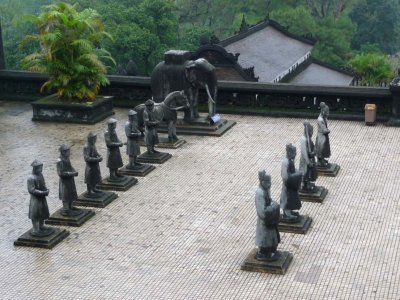
View from the third level of the honor guard of diminutive government officials and one of the horses and elephants. |
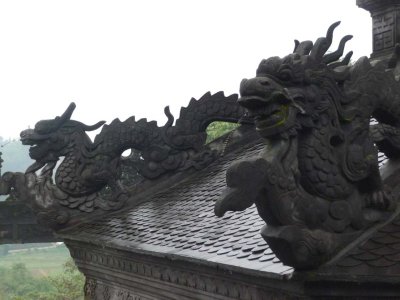
These magnificent stone dragons are on top of entrance gate. |

This tower is very prominent at Khai Dinh's tomb. |

Detail of a dragon design on the tower. |

Architectural designs of the wall on the third level of the tomb. |
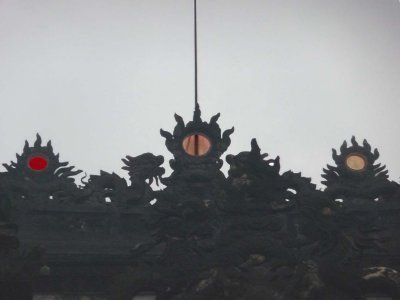
Rooftop details with more dragons. |
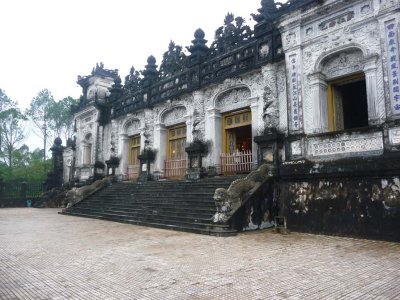
This is the magnificent façade of Khai Thanh Palace where Khai Dinh is entombed. |

Close-up of the dragon stairway of Khai Thanh Palace, which is consistent with the design of the rest of the tomb. |
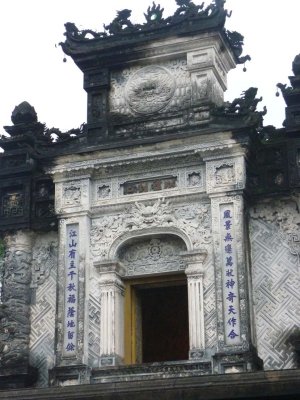
Close-up of the main doorway of the palace. |
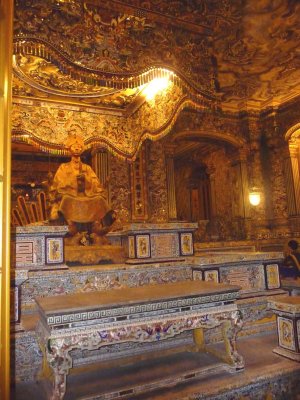
Golden statue in back of the interior of Khai Thanh Palace where Khai Dinh was said to be buried under it. |

A story is that the French tried to open his tomb but found that to open it causes it to collapse. It remains unopened! |
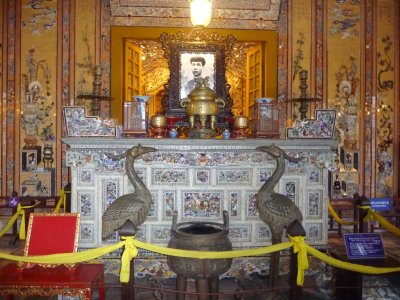
This is a shrine to Khai Dinh with his photo. He looks very young and died at age 40. |
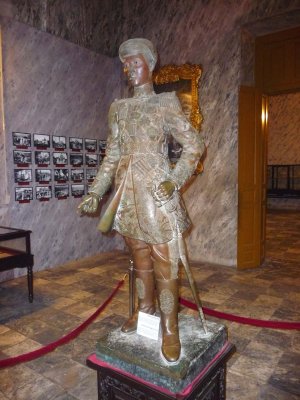
A youthful, life-like statue of Khai Dinh. |

Throughout the interior of the tomb, colored glass and ceramic chips were used to form mosaics of oriental design. |

These dragon designs are an example of the use of colored glass and ceramic chips in Khai Dinh's tomb. |
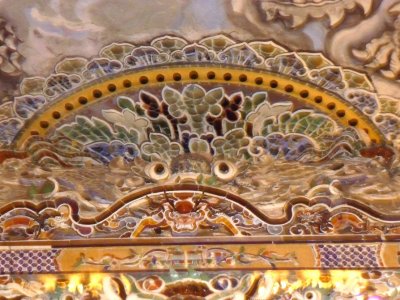
More decorative ceramic and glass dragon designs under an arch. |

In the book, "Art Vietnamien," Khai Dinh's tomb was cited as an example of Vietnamese "neo-classicism." |
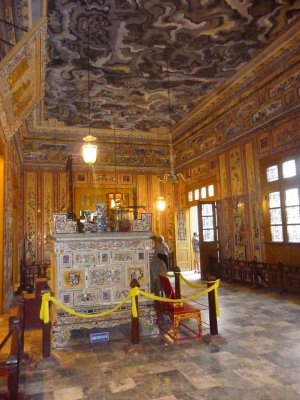
The ceilings were hand painted much like the ceilings of western churches, but the designs are of dragons and clouds. |
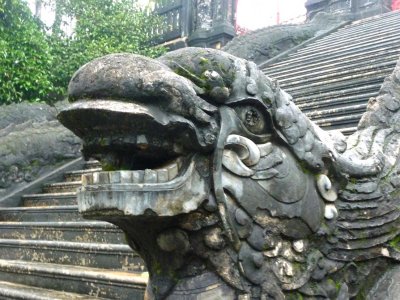
I snapped one last dragon to capture a lasting, final and quintessential impression of Khai Dinh's tomb in my mind forever! |











